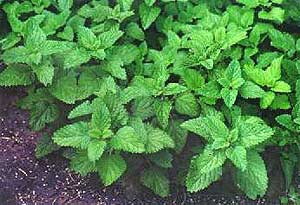|
from 9 june 2002 blue vol II, #37 |
|
|||
|

Centuries ago it had a higher profile, especially in Persia where it was thought of as a cure-all. Legend has it that it also promoted long life. This has much to do with its soothing qualities - as a tea and as an aromatic bath herb. It has been known for centuries to child-bearing women, and women with menstrual problems and cramps. But its most popular use is as a tea at bedtime because it not only induces sleep it also drives cares and worries away. It also helps to ease headaches. Use about six large leaves to a medium sized pot. Native to Europe and a hardy perennial, balm grows well in any conditions and once established will take over a fair proportion of any garden, but try to place it in a sheltered position. It prefers a moist, warm patch of ground which has been well fertilised with manure and seaweed. Grows quickly so pick the leaves off regularly. Its leaves are nettle-like in appearance and like its close relative basil can be used to treat insect bites and stings. Balm also grows well as a pot plant in the kitchen, but it needs a large pot if it is to bush. Despite its associations as a tea, the young balm leaves can be included in leaf salads, as a garnish for fish and in soups, and as a crushed addition to cakes and sweets when a faint lemony flavour is needed. The crushed leaves can also be used as a stuffing - especially if lentils or rice is involved, again to give a faint taste of lemon without the acidity and slight bitterness. For vegans we are going to offer a 17th century recipe made famous by the Carmelite monks of Paris. Balm Spirit The original ingredients were balm leaves, betony leaves, coriander leaves, lemon peel, cloves and cinnamon. With the disappearance of the great European forests, betony in water and wood - this once popular herb in Roman times - has taken a hammering and is now not so well known. Good for the liver and the general well-being of the immune system, if it can be found it should be included in this simple recipe. The major ingredient is balm, about a mug full of leaves, (if they can be found about a quarter a cup of betony leaves), a handful of crushed coriander leaves, a light grating of lemon peel plus two whole cloves and a teaspoon of crushed cinnamon. Infuse this lot in a mug of just boiled water, let it sit for five minutes, strain and drink.
|
| Index |
Next|
